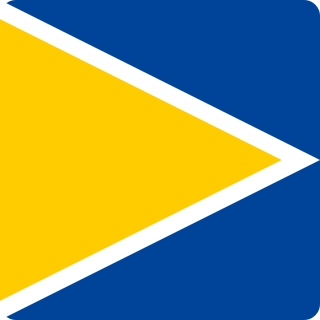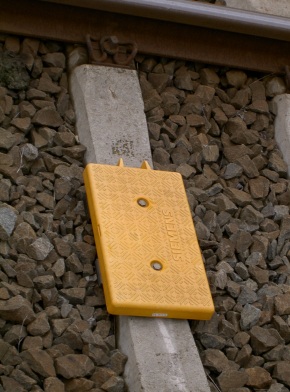
A balise is an electronic beacon or transponder placed between the rails of a railway as part of an automatic train protection (ATP) system. The French word balise is used to distinguish these beacons from other kinds of beacons.

Automatic train control (ATC) is a general class of train protection systems for railways that involves a speed control mechanism in response to external inputs. For example, a system could effect an emergency brake application if the driver does not react to a signal at danger. ATC systems tend to integrate various cab signalling technologies and they use more granular deceleration patterns in lieu of the rigid stops encountered with the older automatic train stop (ATS) technology. ATC can also be used with automatic train operation (ATO) and is usually considered to be the safety-critical part of a railway system.

The European Train Control System (ETCS) is a train protection system designed to replace the many incompatible systems used by European railways, and railways outside of Europe. ETCS is the signalling and control component of the European Rail Traffic Management System (ERTMS).

Linienzugbeeinflussung is a cab signalling and train protection system used on selected German and Austrian railway lines as well as on the AVE and some commuter rail lines in Spain. The system was mandatory where trains were allowed to exceed speeds of 160 km/h (99 mph) in Germany and 220 km/h (140 mph) in Spain. It is also used on some slower railway and urban rapid transit lines to increase capacity. The German Linienzugbeeinflussung translates to continuous train control, literally: linear train influencing. It is also called linienförmige Zugbeeinflussung.

PZB or Indusi is an intermittent cab signalling system and train protection system used in Germany, Austria, Slovenia, Croatia, Romania, Israel, Serbia, on two lines in Hungary, on the Tyne and Wear Metro in the UK, and formerly on the Trillium Line in Canada.

Transmission Voie-Machine is a form of in-cab signalling originally deployed in France and is mainly used on high-speed railway lines. TVM-300 was the first version, followed by TVM-430.
Railway signals in Germany are regulated by the Eisenbahn-Signalordnung. There are several signalling systems in use, including the traditional H/V (Hauptsignal/Vorsignal) system.
A train protection system is a railway technical installation to ensure safe operation in the event of human error.

Integra-Signum is a Swiss train protection system introduced in 1933. Originally it was called Signum; the name Integra was added later. It transmits data inductively and is simple, robust and reliable also in snow.
The European Rail Traffic Management System (ERTMS) is the system of standards for management and interoperation of signalling for railways by the European Union (EU). It is conducted by the European Union Agency for Railways (ERA) and is the organisational umbrella for the separately managed parts of

A Eurobalise is a specific type of a balise installed between the rails of a railway. Eurobalises are part of the European train control system (ETCS). The balises are pre-programmed and contain information that is read by train antennas. One of their many functions is to allow a train to determine its location.
Transmission balise-locomotive is a train protection system used in Belgium and on Hong Kong's East Rail line.
EBICab is a trademark registered by Alstom for the equipment on board a train used as a part of an Automatic Train Control system. Three different families exist, which are technically unrelated.
The Chinese Train Control System is a train control system used on railway lines in People's Republic of China. CTCS is similar to the European Train Control System (ETCS).
The first railway signalling in Greece was installed on the Athens–Piraeus Railway at the turn of the 20th century, when semaphores and boards were added with the line's electrification. Other Greek trains at that time were controlled by signals given manually by station masters. During World War II, German occupation forces installed mechanically operated semaphore signals at the entrance to all stations, with some light signals at busy stations. Modern signalling is provided through colour light signals. Radio communication between train stations and drivers was introduced in 1973 and digital communication is an ongoing present-day introduction.
The Berlin S-Bahn Train Control System - Zugbeeinflussungssystem S-Bahn Berlin (ZBS) - is a train protection system based on Eurobalises that is designed for the specific requirements of the S-Bahn Berlin rapid transit rail network. It is able to gradually replace the old system based on train stops with overlap safety.

Anuncio de Señales y Frenado Automático is an Automatic Train Protection system widely deployed on the Spanish rail network. It consists of a mechanism that stops a train if the driver does not properly heed signals.
The European Rail Traffic Management System (ERTMS) is an initiative backed by the European Union to enhance cross-border interoperability and the procurement of signalling equipment by creating a single Europe-wide standard for train control and command systems.

The train protection system Geschwindigkeitsüberwachung Neigetechnik enables to rise the speed of tilting trains until 30 % above the limits for conventional trains. It is installed on numerous lines in Germany along with the traditional Punktförmige Zugbeeinflussung (PZB) intermittent signalling system.
Automatic Train Protection (ATP) is a method of beacon based railway cab signalling developed by British Rail. The system is only installed on the Great Western Main Line between London Paddington and Bristol Temple Meads, and the Chiltern Main Line from London Marylebone to High Wycombe and Aylesbury.











